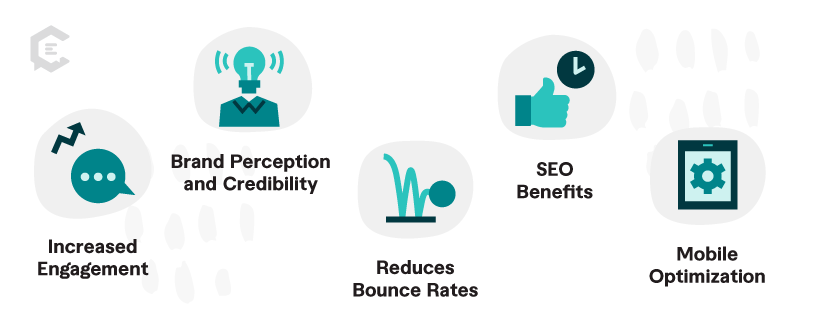What is user experience (UX)?
User experience (UX) refers to a visitor’s overall experience and satisfaction when interacting with a website. This includes but is not limited to:
- Content
- Imagery
- Animation
- Pop-up advertisements
- Checkout flow
- Social media integration
- Navigation
- Interactions
The primary goal is to create an intuitive, enjoyable, and valuable website for its users.
User experience has become vital to any strategy as digital competition grows. When you’re up against others with similar offerings and value propositions, it can make or break a conversion or purchase. If a user becomes confused on your website due to language or image choices, they’ll find another option to fit their needs.

Why is user experience so important?
Thanks to search engine optimization, creating a great user experience on your site is more important than ever. Yes, you want to make your customers happy, but website UX plays an even more significant role in your business. Optimizing UX leads to the following:
Increased Engagement: Engaging and intuitive interactions keep users interested and encourage them to explore more of your offerings.
Brand Perception and Credibility: Users are likelier to trust and have confidence in a brand that provides a seamless and professional online experience.
Reduces Bounce Rates: Reduce bounce rates by keeping users engaged and encouraging them to explore more of your site.
SEO Benefits: As search engines aim to deliver the most relevant and valuable results to users, websites offering good user experiences tend to perform better in search engine rankings.
Mobile Optimization: Websites that provide a seamless experience across different devices tend to perform better in search rankings and cater to a broader audience.
What creates a great user experience for your website?
Creating a polished website is a complex process that goes far beyond design and navigation. Your goal is to simplify and elevate the following factors on your site to prevent potential customers from bouncing too soon.
Design and Layout
A well-designed website should have a clean, aesthetically pleasing layout. It should be easy on the eyes and align with the brand’s identity. Think about your target audience, and ensure you are staying up to date with design trends in the industry. The type of fonts, color schemes, and navigation for a Gen Z website will be different from a corporate B2B company.
Usability
Intuitive navigation, clear menus, and easy-to-find information are essential for a positive user experience. Identify the key data points or services your current users engage with most often. Then, focus on ensuring they can find those factors as effortlessly as possible.
Functionality
All interactive elements on the website, such as buttons, forms, and multimedia, should work correctly. Websites with too many glitches or error messages frustrate customers. Interactive elements, animations, and feedback (such as hover effects and loading indicators) enhance the user’s sense of engagement.

Responsiveness
The website should be responsive and adapt seamlessly to different screen sizes and devices. Be sure to test your layout on all possible platforms to guarantee the format is consistent. This includes:
- Desktops
- Laptops
- Tablets
- Smartphones
Page Load Speed
If you have a lot to offer, it can be easy to overload your site and slow down your loading speed. Optimize your photos and videos by shrinking the file size. And check your site occasionally to ensure any autoplay features seamlessly load.
Accessibility
Ensuring the website is accessible to all users, including those with disabilities, is essential to UX. It involves using proper HTML markup, providing alternative text for images, and offering keyboard navigation options.
Privacy and Security
Implementing security measures and displaying trust signals (such as SSL certificates and customer testimonials) help users feel safe while browsing the website. Suppose you’re a site that handles purchases. In that case, you want to go the extra mile to guarantee your customer’s financial information is safe. So, incorporate recognizable financial institutions using multi-factor authentication.

What creates a great user experience for your content?
Your user experience goes far beyond your website. Customers will get to know your brand through your social media, content marketing, and resources that link back to your site. Ensuring your brand is captivating, consistent, and credible across all your off-page efforts is just as crucial to your UX as your on-page optimization.
Content Quality
High-quality content is well-written, informative, and adds value to the users. By incorporating quality content, you build trust and credibility with your audience.
Clear Call-to-Actions (CTAs)
Your audience will respond better to your online presence if your CTAs are clear and concise. Your CTA’s should offer value to your customers, like subscribing to a newsletter, downloading a resource, or making a purchase. Tell them you can answer their pain if they simply follow a specific action.
Personalize your content
Users have a better experience when they feel the content speaks directly to them. General, wide-net approaches to content leave customers feeling confused and sold to, rather than establishing an authentic connection with your brand.
Analyzing User Behavior
Use data and analytics to track user interactions with your content. This will help you understand what works well and identify areas for improvement.
Ready to take your user experience to the next level?
A good user experience is essential for your website’s success. It can significantly impact various aspects of your online presence. That includes user satisfaction, engagement, conversion rates, and brand perception. It’s an investment that can yield substantial returns for every part of your business.
Your website copy is a significant part of getting your visitors to stay longer. It also contributes to their overall experience of your brand. To boost your conversions and overall user experience, talk to a content specialist at ClearVoice today!



